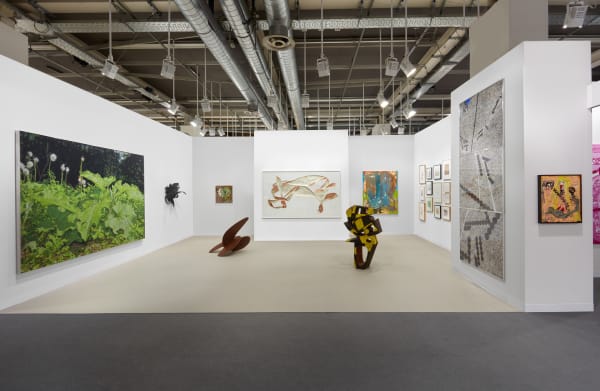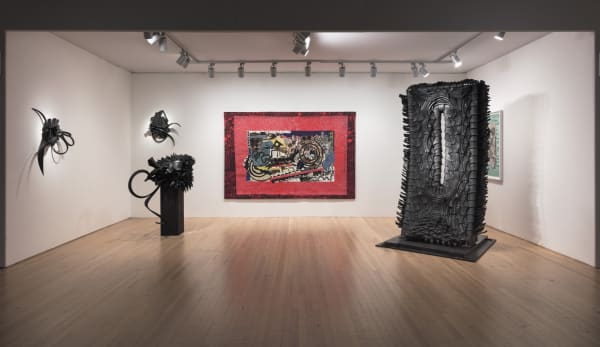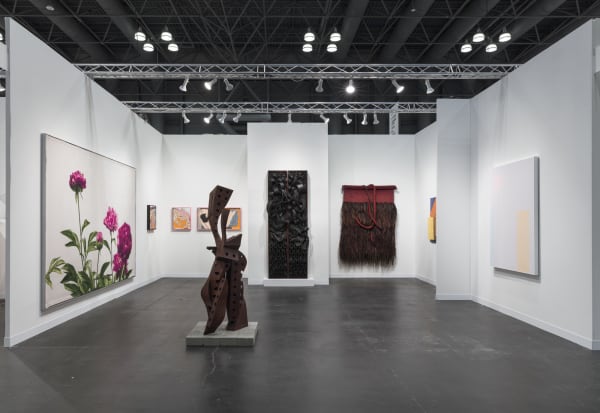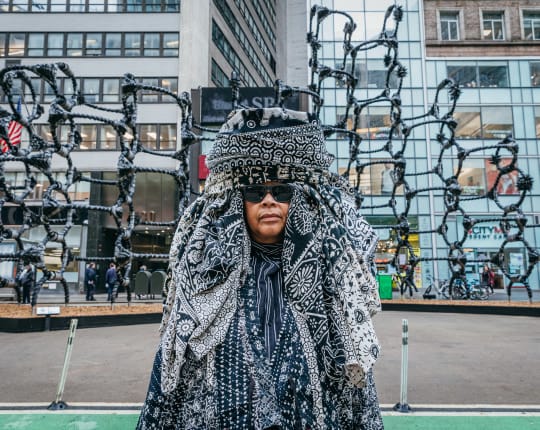-

-

-
-
-
News
-
Monumental sculptures by Chakaia Booker presented at the National Gallery of Art
ArtDaily April 5, 2025WASHINGTON, DC .- For over four decades, Chakaia Booker (b. 1953) has cut, coiled, and contorted used tires, transforming this industrial waste into abstract sculpture....Read more -

In the Tower: Chakaia Booker
National Gallery of Art, Washington, D.C. | April 5–August 2, 2026 April 5, 2025For over four decades, Chakaia Booker has cut, coiled, and contorted used tires, transforming this industrial waste into abstract sculpture. She selects found, weathered fragments...Read more -

Circle Lecture on In the Tower: Chakaia Booker: Treading New Ground
National Gallery of Art | Friday, April 4, 2025, 10:00 a.m. – 12:00 p.m. April 4, 2025Friday, April 4, 2025, 10:00 a.m. – 12:00 p.m. East Building Auditorium Join us for a lecture on In the Tower: Chakaia Booker: Treading New...Read more -

Garment District Artist Talk: Chakaia Booker and Xin Song
Garment District, Manhattan October 19, 2024On Saturday, October 19 at 4:30pm, join artists Chakaia Booker and Xin Song for a talk about their new public works on view in the...Read more -

Currently Speaking: Artist Talk with Justin Sanz and Chakaia Booker
October 17, 2024The Current is pleased to host an Artist Talk with Justin Sanz and Chakaia Booker as part of our monthly Currently Speaking series. The talk...Read more -

Chakaia Booker: Shaved Portions Installation Viewing and Artist Talk
Presented by ArtTable July 11, 2024Meet ArtTable in Midtown for a viewing of Chakaia Booker’s Shaved Portions before heading over to the Elizabeth Foundation for the Arts’ Robert Blackburn Printmaking...Read more -

Taking Time: A Solo Exhibition by Chakaia Booker
The Current: A Center for Contemporary Art, Stowe, VT | June 22 - October 19, 2024 June 22, 2024Chakaia Booker’s work has spanned decades with an intentionality of practice and purpose. She chooses discarded tires to create beauty from detritus, and elegance from...Read more -

Chakaia Booker's "Shaved Portions" Opens in the Garment District
April 18, 2024NEW YORK – April 18, 2024 – A 35-foot-tall abstract sculpture comprised of deconstructed rubber tires is towering above the Garment District as part of...Read more -

Chakaia Booker's Outdoor Sculpture 'Shaved Portions' Opening Event
April 17, 2024The GDA Art On The Plazas is thrilled to have Chakaia Booker return for an exhibition of her incredible work. Please join us, or just...Read more -

Chakaia Booker in "Century: 100 Years of Black Art at MAM"
Montclair Art Museum, Montclair, NJ | February 9 - July 7, 2024 February 9, 2024The largest of its kind in the Museum’s history, this exhibition celebrates the dramatic growth of MAM’s collection of works by Black artists. Ranging from...Read more
-
-
Press
-
‘Now I’m on the Stage’: 7 Artists on Their Museum Residencies in Harlem
Seph Rodney · The New York Times November 14, 2025The Studio Museum in Harlem’s longtime residency program has been pivotal to artists of color. Here, alumni look back on why it was so crucial to them. The Studio Museum... -
An Artist Who’s Been Using the Same Woodblock for Over 15 Years
Precious Adesina · The New York Times September 10, 2025Chakaia Booker discusses printmaking and evolving old patterns. In Solo Show , we ask Black artists to curate a list of three treasured works that they’ve encountered or made, and... -
Chakaia Booker by Stephanie E. Goodalle
Stephanie E. Goodalle · BOMB Magazine July 23, 2025Making a monumental weaving with discarded tires Hailing from Newark, New Jersey, multimedia artist Chakaia Booker explores the urban landscape through refuse. Most widely known for her sculptures composed of... -
The noxious future of Chakaia Booker’s prophetic tire sculptures
Kristin Capps · The Washington Post May 21, 2025The sculptor’s monumental tire tapestries at the National Gallery of Art, alongside her haunting prints, are painstakingly crafted and subtly menacing. In a row of six images at the National... -
6 Artists Reveal The Details of Their Creative Process
Osman Can Yerebakan · L'Officiel December 6, 2024Chakaia Booker “The initial appeal of tires was the surface texture, the designs and patterns created by the manufacturers for grabbing the road and wicking rain and snow away,” Chakaia... -
Chakaia Booker: Empty Seat
Farren Fei Yuan · The Brooklyn Rail November 27, 2024At David Nolan’s townhouse space this November, one does not see but smells the art first. A double door opens onto a long, narrow corridor linking two air-tight rooms, one... -
‘Getting Stuck Isn’t an Option’: Sculptor Chakaia Booker Is Still Building at 71
Katie White · Artnet July 24, 2024The artist recently debuted 'Shaved Portions,' a colossal sculpture made of salvaged rubber tires installed in New York's Garment District. Right now, in Manhattan’s Garment District, a towering 35-foot black... -
Artist Chakaia Booker’s Endless Imagination
Grace Edquist · Vogue June 28, 2024Since mid-April, a 35-foot-tall labyrinth of steel and rubber has loomed over the storefronts of Manhattan’s Garment District. The monumental public sculpture, titled Shaved Portions, is the creation of Chakaia... -
Spotlight: Artist Chakaia Booker’s Rubber Tire Sculptures Sit at the Intersection of Culture, Economics, and Transportation
Artnet Gallery Network · Artnet June 14, 2023What You Need to Know: American artist Chakaia Booker—widely recognized for her extensive use of recycled rubber tires in her work—is currently the subject of a solo show with David... -
Chakaia Booker: Public Opinion
Alfred MacAdam · Brooklyn Rail June 1, 2023Chakaia Booker is a busy artist. On any given workday she paints, sculpts, and makes prints—seemingly all at the same time. Examples of all three media are crammed into the... -
Editors’ picks: six shows not to miss in February
Art Basel February 20, 2023‘Against The Day: Chakaia Booker & Carol Rama’ Galerie Isabella Bortolozzi , Berlin Until March 25, 2023 The body, materiality, and intuition take center stage in this striking juxtaposition of... -
Monumental sculptures by Chakaia Booker presented at the National Gallery of Art
ArtDaily April 5, 2025WASHINGTON, DC .- For over four decades, Chakaia Booker (b. 1953) has cut, coiled, and contorted used tires, transforming this industrial waste into abstract sculpture. Gravitating toward found, weathered tires,...
-
-
Exhibitions
-

CHAKAIA BOOKER
Empty Seat November 1 - December 21, 2024Chakaia Booker is one of the foremost sculptors of her generation. For over four decades, Booker has masterfully manipulated the rubber tire into forms previously unimaginable. In doing so she...Read more -

CHAKAIA BOOKER PUBLIC ART
Broadway (between 39th and 40th Streets) April 18, 2024 - February 20, 2025 New YorkNEW YORK – April 18, 2024 – A 35-foot-tall abstract sculpture comprised of deconstructed rubber tires is towering above the Garment District as part of the Garment District Alliance’s latest...Read more -

CHAKAIA BOOKER
Public Opinion May 5 - July 20, 2023Public Opinion , Chakaia Booker’s inaugural exhibition with David Nolan Gallery, showcases the artist’s signature approach to abstraction developed over the last four decades. Booker, a fixture of the New...Read more
-
-
Art fairs
-

ART BASEL PARIS
October 22 - 26, 2025David Nolan Gallery is delighted to present a salon-style installation of master works on paper for its debut at Art Basel Paris. Featuring works spanning...Read more -

ART BASEL
Booth A9 June 19 - 22, 2025For this edition of Art Basel, David Nolan Gallery will present a selection of contemporary works by Rodolfo Abularach, Richard Artschwager, Enrico Baj, Georg Baselitz,...Read more -

ART BASEL MIAMI BEACH
BOOTH E6 December 4 - 8, 2024For this year’s edition of Art Basel Miami Beach, David Nolan Gallery is pleased to present selected sculptures, paintings and works on paper by a...Read more -

ART BASEL
Hall 2.0 | Booth A9 June 11 - 16, 2024Featuring works by: CARL ANDRE RICHARD ARTSCHWAGER ENRICO BAJ CHAKAIA BOOKER WILLEM DE KOONING CARROLL DUNHAM DAVID HARTT MEL KENDRICK BARRY LE VA BRICE MARDEN...Read more -

DALLAS ART FAIR
April 4 - 7, 2024Read more -

ART BASEL MIAMI BEACH
Miami Beach Convention Center December 6 - 10, 2023For this year's edition of Art Basel Miami Beach, David Nolan Gallery celebrates a large group of artists with widely varying global perspectives. A woven...Read more -

ADAA
The Art Show November 1 - 5, 2023For the 2023 edition of The Art Show organized by the Art Dealers Association of America at the Park Avenue Armory, David Nolan Gallery is...Read more -

ART BASEL
Booth A10 June 13 - 18, 2023RICHARD ARTSCHWAGER ENRICO BAJ CHAKAIA BOOKER DAVID HARTT MEL KENDRICK BARRY LE VA JONATHAN MEESE JIM NUTT PAULO PASTA DOROTHEA ROCKBURNE ROBERT SMITHSON JORINDE VOIGTRead more -

DALLAS ART FAIR
April 21 - 23, 2023Chakaia Booker William Copley Deborah Druick Julia Fish Mona Hatoum Mel Kendrick Barry Le Va Jonathan Meese Wardell Milan Paulo Pasta Dorothea Rockburne Peter Saul...Read more -

ART BASEL MIAMI BEACH
Miami Beach Convention Center November 29 - December 3, 2022Chakaia Booker William Copley Carroll Dunham Julia Fish David Hartt Mel Kendrick Martin Kippenberger Barry Le Va Jonathan Meese Wardell Milan Jim Nutt Albert Oehlen...Read more -

ADAA
The Art Show November 2 - 6, 2022For this edition of The Art Show, David Nolan Gallery is delighted to announce a group presentation of artists from different generations and cultures whose...Read more -

THE ARMORY SHOW
September 9 - 11, 2022Chakaia Booker Carroll Dunham Julia Fish David Hartt Mel Kendrick Jonathan Meese Norberto Nicola Albert Oehlen Paulo Pasta Dorothea Rockburne Jorinde VoigtRead more -

ART BASEL
June 16 - 19, 2022For the 2022 edition of Art Basel, David Nolan Gallery is pleased to present a selection of works by artists from the gallery’s program as...Read more
-
MAILING LIST SIGN-UP
By completing this form, you confirm that you would like to subscribe to DAVID NOLAN’s mailing list and receive information about exhibitions and upcoming events. Your email address will be used exclusively for the mailing list service.
* denotes required fields
We will process the personal data you have supplied to communicate with you in accordance with our Privacy Policy. You can unsubscribe or change your preferences at any time by clicking the link in our emails.






































